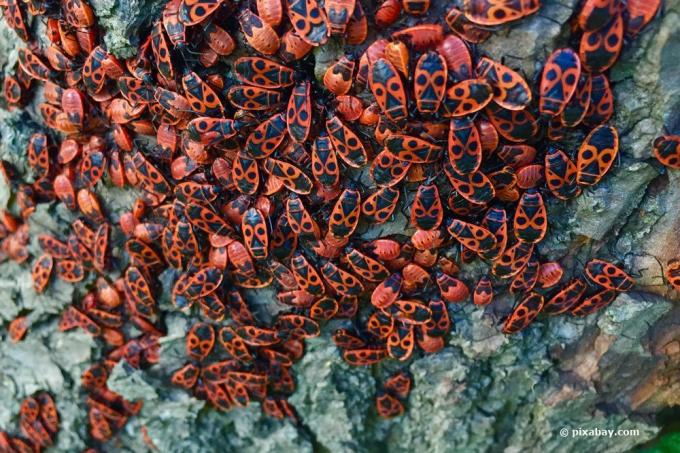
table of contents
- Red beetle
- Fire bug (pyrrhocoris apterus)
- Fire beetle (Pyrochroa)
- Lilies (Lilioceris lilii)
- Red Head Beetle (Anthocomus rufus)
- European beetle (Lycidae)
- Red velvet mite (Trombidium holosericeum)
When the temperatures start to rise in spring, the beetle season begins. They are usually only noticeable when you sit on the balcony or terrace in summer. Not every sight of a red beetle is pleasing, like that of a ladybug. But what are they all about and do they have to be fought?
Red beetle
Small crawling animals, especially those with a red body, seem "threatening" to many. Countless specimens in a wide variety of red tones, shapes and sizes cavort among the beetle species. They usually appear in whole columns and can be found in flower beds, on a wall or on the wall of a house. But many are useful helpers against pests in the garden.
Fire bug (pyrrhocoris apterus)
In most cases the fire bug is confused with a beetle, which is why it should be omitted here when mentioning red beetles. The fire bug is a genus of bugs that can be found in the garden between early summer and late autumn.
Recognize:
- red to dark red color
- mostly light black patterns on the body
- Size: about one centimeter
- short fore wings
- can't fly
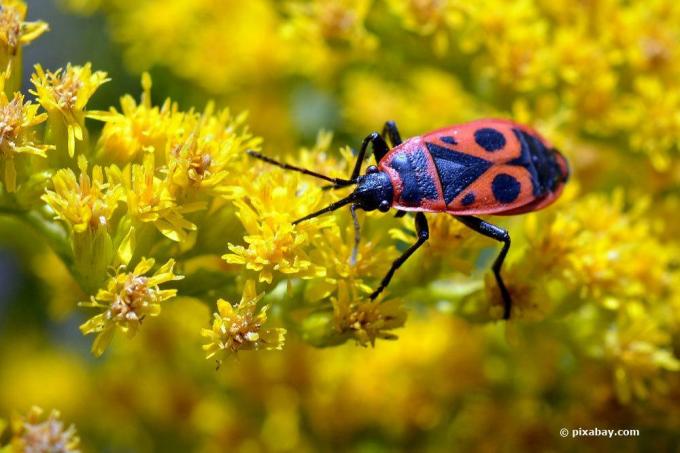
Preferred residence areas:
- dry locations
- Europe-wide occurrence
- especially love linden trees, acacias and mallows
- old seed stocks of flowers
To use:
Fire bugs are of no real use in the garden. They feed mainly on seed residues that remain after the flowering period. Dead insects are also one of their favorite foods. Since they can give off an unpleasant smell to ward off enemies, they keep mosquitoes and Co. away in their immediate vicinity. This is advantageous if they have settled on terraces and balconies. They are not dangerous and are not a pest that should be controlled. Since they like to appear in huge columns and also get into the house through cracks in the house wall, doors and windows, they are often perceived as annoying.
Combat:
Small red "bugs", which actually belong to the bugs, can be fought in the house with a conventional insecticide for flies and spiders.
In the garden, withered inflorescences should be cut off so as not to attract them. If you have already spread out in the garden, on a wall or house wall, you should not use an insecticide. Other beneficial insects could otherwise be killed. Spraying them with a soapy water solution causes them to die off without involving other small creatures in the garden.
Fire beetle (Pyrochroa)
The small, deep red fire beetle Pyrochroa coccinea is most common in German gardens. There are other species of this beetle genus, but they are less common in Germany. These include the red-headed fire beetle (Pyrochroa serraticornis) and the orange-colored fire beetle (Schizotus pectinicornis).
Recognize:
- flat, elongated body
- Size: about two centimeters
- scarlet color
- black head
- preferred whereabouts
- Woods
- Forest edges
- on flowers also in the garden
- on dead wood on trees or on the compost
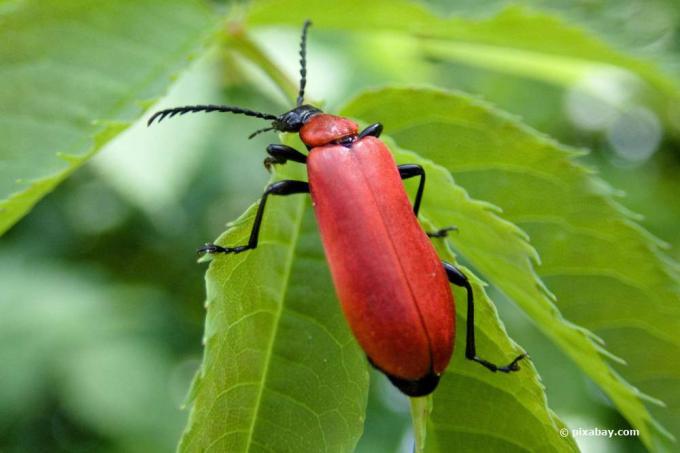
To use:
The fire beetle feeds mainly on seeds, mushrooms and dead wood. He likes to eat the larvae of other insects. The bark beetle, for example, is one of these. It is a plant pest and can kill entire trees. With fire beetles you keep numerous plant pests at bay.
Combat:
Because of their usefulness, fire beetles should only be controlled if they are perceived as bothersome. They are not a threat to humans and are therefore neither dangerous nor toxic. It does not harm plants.
Lilies (Lilioceris lilii)
As little red beetles, the lily chickens are often noticeable in gardens between May and September. It is a leaf beetle that should be taken “seriously”.
Recognize:
- red pronotum
- Size: between six and eight millimeters
- black legs
- elongated head that narrows behind the eye area

Preferred whereabouts:
- Lilies
- lily of the valley
- Imperial crowns
- Flower bulbs (larvae of the lily chickens)
- Deciduous trees such as alder and birch
- Hedges
To use:
Lily chickens are of no use, they are harmful to your plants. They will eat every type of lily except for the stems if they are not stopped. Their larvae feed on flower bulbs, which they can destroy completely. If you see small red beetles, you should immediately find out whether they are lily broilers in order to control them.
Combat:
The most effective and quickest is an insecticide that is also used for aphids and mites. Rapid control is advisable so that as little plants as possible suffer damage and, in the worst case, die.
You can also collect the beetles as "first aid" when no insecticide is readily available. Place newspaper or kitchen paper under the affected plants, push the beetle off the plant with a stick and dispose of it together with the paper airtight in the household rubbish or burn it.
Red Head Beetle (Anthocomus rufus)
The little red pointed beetle is also known under the name two-spotted pointed bug. It is a species of beetle from the Melyridae family and appears predominantly from July to October. Their concise appearance allows them to be easily identified as ear beetles.
Recognize:
- red elytra and pronotum
- Size: about five millimeters
- black legs
- colored black-red under the wings
- black spot between head and trunk
- black abdomen
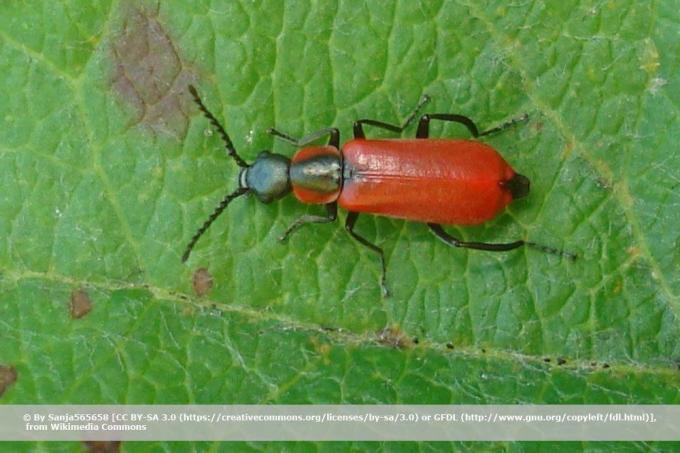
Preferred location:
- Deadwood
- Undergrowth
- Trees
- swampy and damp meadows
- at bank and pond edges
- reed
To use:
The pointed beetle is of great use in gardens. In the thicket as well as in the under- and on dead wood he goes in search of food. His favorite foods include larvae, pollen and dead insects. By eating larvae in particular, these red beetles ensure fewer pests in gardens, such as the black weevil. By eating pollen, it contributes to the "air purification", which is particularly beneficial for pollen allergy sufferers.
Combat:
Due to its high utility factor, the head beetle is a valuable living creature in gardens and should not be controlled. In some cases it is even attracted to eat harmful larvae.
Should it still be disturbing, it is advisable to lure it with sugar water. Here it can then be collected and placed elsewhere outside of your own garden.
European beetle (Lycidae)
One of the largest families of beetles is the red cap beetle, which has over 3000 different species. Only eight species are known in Central Europe.
Recognize:
- orange-red to brownish-red body
- Size: depending on the type, between three and 80 millimeters
- mostly longitudinally grooved surface structure
- six-legged
- mostly flattened body
- Demarcation between head and trunk
- Head depending on the species, black or with prominent eye areas

Preferred location:
- thicket
- rotten wood
- blossoms
- leaves
- Tree stumps
- Scratching a wall (hiding place)
To use:
According to previous knowledge, red cap beetles have no advantageous use. Their way of life is not yet well known because they have not been in the local area for long.
Combat:
This red type of beetle does not usually appear in moderation, but is usually a single animal or a small group of five to ten beetles in the vicinity. You actually only live outdoors, but you can also "get lost" inside the house. They do not cause damage to plants. Combating with the aim of killing is not necessary. Rather, the beetles should be collected and ideally released in the forest.
Red velvet mite (Trombidium holosericeum)
Although the red velvet mite is not a beetle, it is often mistaken for it, especially if it is spotted on a house wall or wall. Especially in summer they often frolic in groups in the sunshine.
Recognize:
- completely red body including antennae
- Size: up to four millimeters
- scarlet hair
- soft body cover
- stalked eyes
- scissor-shaped jaw claws
- Eight-legged
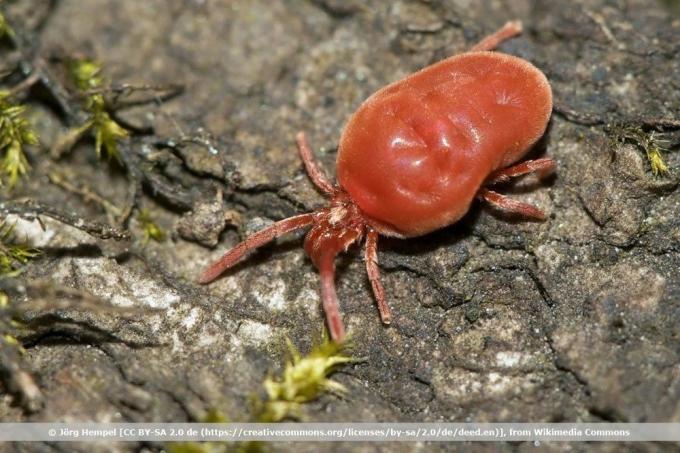
Preferred whereabouts:
- House walls and walls
- Plant leaves
- on dried leaves in the sun
- warmed stone slabs
- sometimes found on patio furniture in the sun
- grasslands
To use:
The beetle-like velvet mites are of great use because they feed on insect eggs and small garden pests such as aphids.
Combat:
Since they are harmless to plants of any kind and to humans and many pests eat in gardens, control is not appropriate. If you should head towards the house in cooler evening temperatures, simple mosquito screens protect against penetration.
